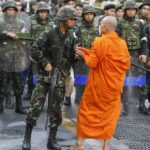December 18, 2023
We hope you enjoy our articles. Please note, we may collect a share of sales or other compensation from the links on this page. Thank you if you use our links, we really appreciate it!
The Supreme Court of India in a recent judgment upheld the Indian government’s policy in 2019 that revoked the troubled region’s special status as incorporated in Article 370 of the Constitution of India. The special status, designed to be ‘temporary’, had granted autonomy to the region and limited the scope of Indian laws. Though the judgment enabled India to bolster its control over the region, the protracted social conflict in Jammu and Kashmir remain a Gordian knot and it will be a difficult process to bring genuine peace to one of the most troubled regions in the world.
The territory of Jammu and Kashmir is trifurcated between India, Pakistan and China. Its location on the Himalayas, with volatile seismic zones and glaciers, and on the Silk Road, not only makes it one of the high-altitude conflicts, but also one of the most volatile geopolitical conflicts, in which three wars, in 1947, 1965, and 1971, and a limited war in 1999 were fought. The region also fits into the contested clash of civilization theory, forwarded by political scientist Samuel Huntington, in which the world civilizations, in this case, Hinduism and Islam are in clash. Going back farther in history, Indian subcontinent was a British colony until 1947, and the clash of two visions – the Gandhian vision of pluralism and the Jinnah’s vision of two-nation theory, implying Hindus and Muslims are two nations hence they are entitled to two separate states, – guided the fate of independence of the subcontinent, and on it emerged two independent states, India and Pakistan.
The conflict in Jammu and Kashmir is multilayered. As one of the most protracted conflicts in the world, its origins could be traced to 1947, when India and Pakistan were created. The princely state (Jammu and Kashmir was one among 500 and odd princely states, but one that abutted India and Pakistan) acceded to India, which was disputed by Pakistan. Pakistan has argued that as a Muslim majority state, the region, following the logic of Jinnah’s two-nation theory, must be part of Pakistan. Though Pakistan has often harped on its logic of political, moral and diplomatic support to the Kashmiris’ right to self-determination, it has exercised total control on the part of the region under its control and supported the separatist movement in the region under the control of India.
China was added to the mix when, after the India-China war in 1962, Pakistan handed part of its controlled territory to China as a gesture of friendship and as a bulwark against India. China also took control of part of the territory after the war. But a violent internal dimension was added in the 1980s as there was a violent upsurge in the Kashmir valley, as the local people’s alienation took a massive turn and they openly protested against Indian policies. India’s promotion of corrupt leaders, undermining local empowerment and aspirations, and rigging of elections led to the alienation. Pakistan supported the insurgency as it could see in it an opportunity to challenge India’s rule. Heavy deployment of armed forces and the Indian policy to counter militancy through force further accentuated the alienation. The generation that grew up in the late 1980s and afterwards lived the conflict in their everyday lives. Violent Islamic extremism also led to the massive exodus of Kashmiri Pandits from the valley in the 1990s. The exodus almost ended the remnants of pluralism from the valley.
Not that there were no attempts, both internal and external, to bring peace in the region. Agreements including Tashkent 1966, Simla 1972, Lahore 1999, Ceasefire Agreement of 2003, opening of intra-Kashmir routes for trade and travel in 2006, 2007 and 2008, ignited hopes for peace. But lack of bold vision, prioritization of immediate strategic interests over long term demands of positive peace, promotion of spoilers of peace, have contributed to the protracted nature of the conflict, even though there were periods of thaw.
The recent Indian Supreme Court judgment might have bolstered Indian position in Jammu and Kashmir, but the conflict remains far from resolved. Pakistan has expressed disapproval of the judgment and its leaders have announced that they will contest the Indian position in international forums. The local leaders in the valley have remained dismissive or muted about the recent development. The judgment might have strengthened the ruling BJP party and its prospects in the general election next year, but the Gordian knot called Jammu and Kashmir would continue to remain protracted.



